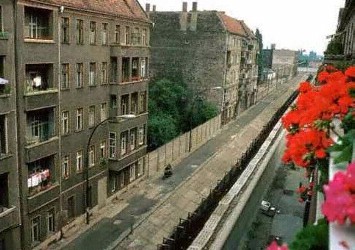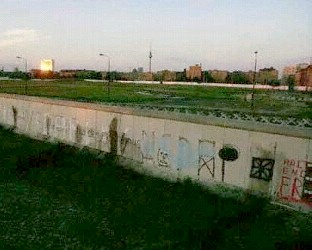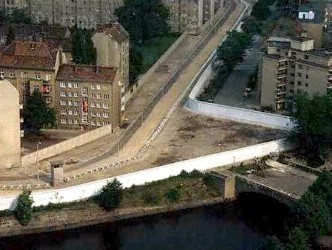  
After World War II, Germany was split; West Germany was controlled by the West, while communist East Germany was controlled by the Soviet Union. Berlin was also divided, despite the fact that it was located entirely within the communist East. At first the residents of Berlin were allowed to move freely back and forth between the sectors. However, as the Cold War progressed, movement was restricted; finally the border between East and West Germany was closed in 1952; only in Berlin did the border remain open. Taking advantage of this last gateway, approximately 2.5 million East Germans crossed into the West between 1949 and 1961 through Berlin. Construction of a barrier by the East Germans around the western sector began on August 13, 1961 in East Berlin. It first consisted of barbed wire, which was later replaced by a wall. The wall physically divided the city and completely surrounded West Berlin. East German officials described their wall as an 'antifascist wall of protection', intended to avoid 'aggression from the West'. The West claimed that the wall was created to prevent the East German citizens from entering West Berlin and West Germany. During the construction of the wall and afterwards, East German soldiers manned the wall with orders to shoot anyone who attempted to defect. In the center of the city, observation towers, flood lights and patrol dogs constantly monitored the strip of land near the wall. Additionally, the whole length of the border between East and West Germany was closed with fences, walls, and other installations. The Berlin Wall was an intimidating barrier covered with barbed wire and patrolled by armed guards. Despite this, thousands managed to escape through or over the wall, which divided the city of Berlin for 28 years. Hundreds also died while trying to escape to the West. The last person to be shot trying to cross the border was Chris Gueffroy on February 6, 1989. The Berlin Wall itself was over 155 km long and was eventually guarded by over 300 watch towers and thirty bunkers. In June 1962 work started on a second parallel wall, creating an empty, easily observable 'No Man's Land' between the two walls. People living near the wall on the Eastern side were relocated and their houses were torn down. A more modern wall was begun in 1975, made from reinforced concrete; it was 3.6 m high. In 1987, Ronald Reagan gave a speech at the Brandenburg Gate, at which he challenged Mikhail Gorbachev, then the leader of the Soviet Union, to 'tear down this wall'. On August 23, 1989, Hungary removed its border restrictions with Austria, and that September more than 13,000 East Germans escaped through Hungary. Mass demonstrations against the government in East Germany began late in 1989. The leader, Erich Honecker, resigned on October 18, 1989. When in a press conference televised live on East German TV it was announced (apparently mistakenly) that all restrictions had been lifted, tens of thousands of people immediately went to the wall, where they quickly became a serious problem for the surprised border guards. There was no way to hold back these large numbers of East German citizens; probably the only way would have been to shoot them, but this would have meant massacring huge numbers of the country's own citizens - which the authorities were not willing to do. In face of the huge crowd, the guards eventually just gave way, opening the access points and allowing people through. Jubilant East Berliners were greeted by West Berliners on the other side in a party atmosphere. East German guards fled as well. November 9 is thus considered the date the wall fell. The fall of the wall was the first step to the reunification of Germany, which was formally concluded on October 3, 1990. Not much is left of the wall in Berlin today. It was destroyed almost everywhere, except for three short segments. Even the parts that are left standing no longer accurately portray the wall's original appearance: they are badly damaged (since so many people attempted to pick up 'original Berlin Wall' pieces), and today graffiti covers the eastern side of the Wall (which didn't happen while the wall was actually guarded by the heavily armed soldiers of East Germany). |